The methods of metal thread cutting are mainly turning, milling, tapping, etc. Today, Xiaobian brings you the most common technical knowledge of thread turning in production to share with you.
1. Important basic knowledge of thread processing
1. Definition of Terms
  
Spiral angle:
-The helix angle depends on the diameter and pitch of the thread.
-Adjust the flank back angle of the blade by replacing the blade pad.
-The blade inclination angle is γ. The most common blade inclination angle is 1°, which corresponds to the standard shim in the tool holder.
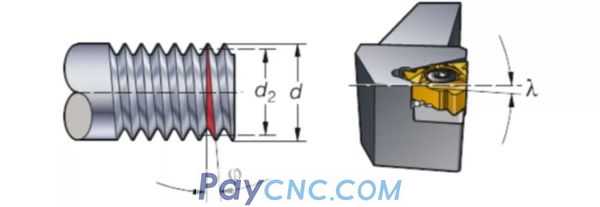
Cutting force when cutting in and out of thread:
-The highest axial cutting force in the threading process occurs during the cutting tool cutting into and out of the workpiece.
-Excessive cutting parameters may cause unreliable insert movement.
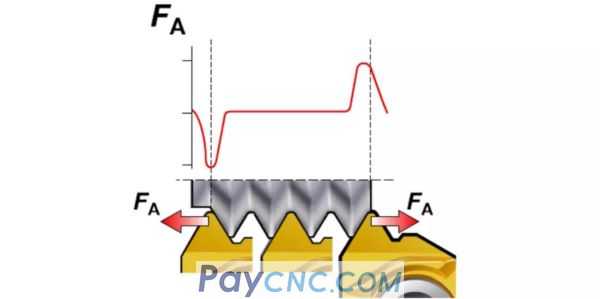
Tilt the blade to obtain clearance:
The blade inclination can be set under the blade in the shank using the blade pad. You can refer to the chart in the tool catalog to choose which tool pad to use. All tool holders are equipped with standard tool pads with blade inclination set to 1°.
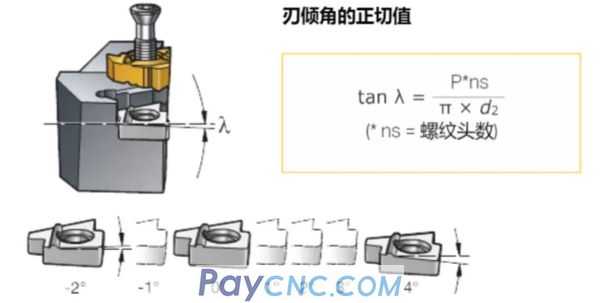
Select the shim according to the blade inclination. Workpiece diameter and pitch will affect the blade inclination. As can be seen from the figure below, the workpiece diameter is 40mm, the pitch is 6mm, and the required tool pad must have a blade inclination of 3° (standard tool pads cannot be used).

Marking of threading blades and shim:
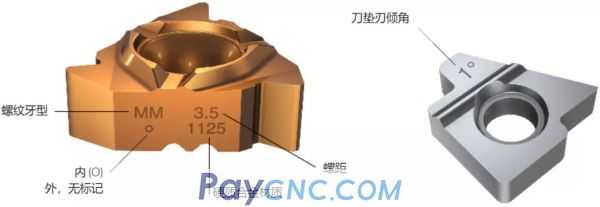
Thread shape and its application:
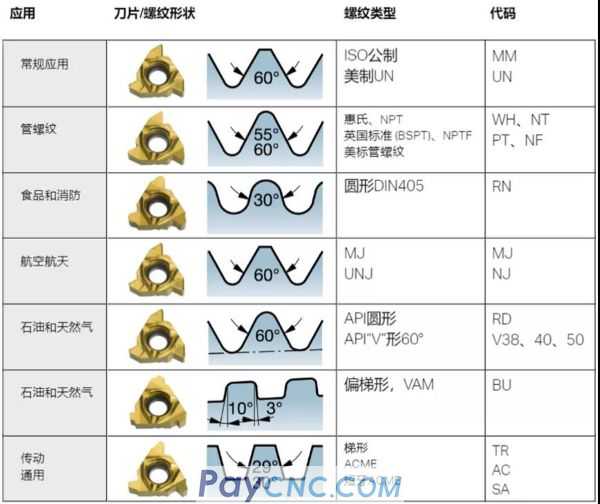
Second, the type of threaded blade and clamping scheme
1. Multi-tooth blade

advantage:
-Reduce the number of feeds
-Very high productivity
Disadvantages:
-Needs stable clamping
-After machining the thread, sufficient space for retraction is required
2. Full tooth blade

advantage:
-Better control of thread shape
-Less glitches
Disadvantages:
-One blade can only cut one pitch
3. V tooth blade
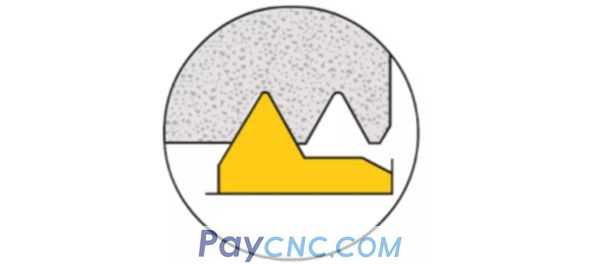
advantage:
-Flexibility, the same blade can be used to process several pitches.
Disadvantages
-It will cause burrs to form and need to be removed.
Clamping scheme i-LOCK:
-Extremely rigid thread machining with fixed blades
-The blade is positioned in the correct position under the guidance of the guide rail
-The screw presses the blade on the rail back to the radial stop at a contact surface (red contact surface) in the blade holder
-Reliable blade interface ensures longer tool life and higher thread quality
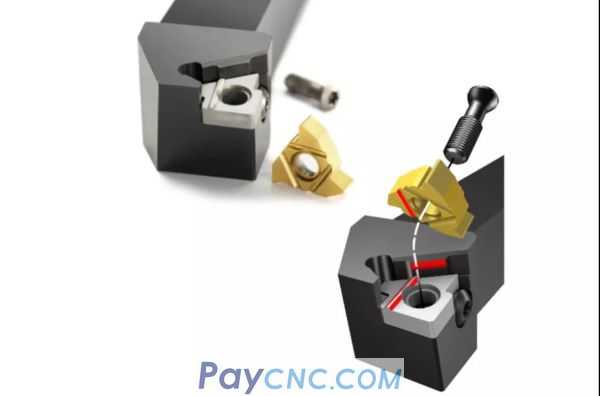
Various tool holders:

Three, three different types of feed methods
The feed method can have a significant impact on the threading process. It will affect: cutting control, blade wear, thread quality, tool life.
1. Improved lateral feed
Most CNC machine tools can use this feed method through a cycle program:
-Chips and traditional turning types-easier to form and guide
-Axial cutting force reduces vibration risk
-Thick chips, but only in contact with one side of the blade
-Reduced heat transfer to the blade
-First choice for most threading operations
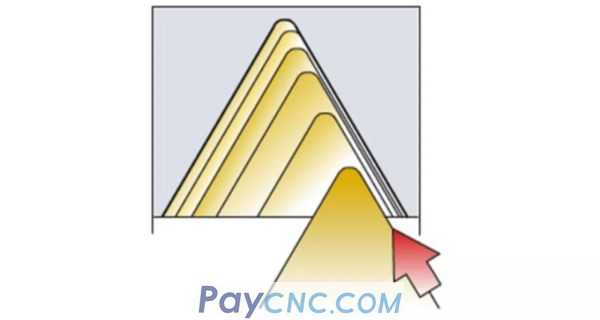
2. Radial feed
The most commonly used method-the only method that can be used by earlier non-CNC lathes:
-Produce hard "V" shaped chips
-Even blade wear
-The blade seat is exposed to high temperature, which limits the depth of penetration
-Suitable for processing fine thread
-Vibration and poor chip control when machining coarse thread
-First choice for work hardened materials
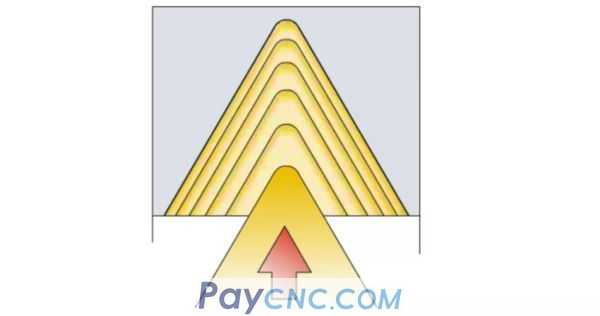
3. Alternating feed
-Recommended for large teeth
-Even blade wear and maximum tool life can be achieved when machining threads with very large pitches
-Chips are guided in two directions, so it is difficult to control

4. Methods to improve processing results
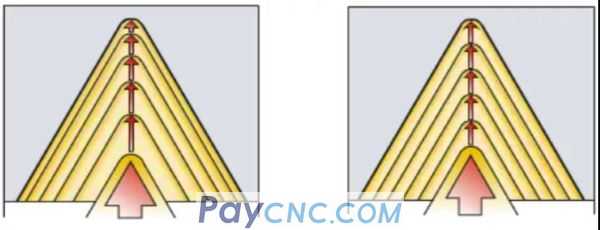
Cutting depth decreases layer by layer (left), constant cutting depth (right)
1. The cutting depth decreases layer by layer (the chip area remains unchanged)
It can achieve a constant chip area, which is the most commonly used method in CNC programs.
-The first pass is the deepest
-Follow the recommended values on the feed table in the catalog
-More "balanced" chip area
-The last pass is actually about 0.07mm
2. Constant depth of cut
Regardless of the number of passes, the depth of each pass is equal.
-Higher requirements for blades
-Ensure optimal chip control
-Not applicable when the pitch is greater than TP1.5mm or 16TP
Use the extra margin to refine the thread crest:
Before machining the thread, it is not necessary to turn the blank to the exact diameter, and use the extra margin/material to refine the thread crest. For the refined tooth crest insert, the previous turning process should leave 0.03-0.07mm of material to make the crest shape correctly.
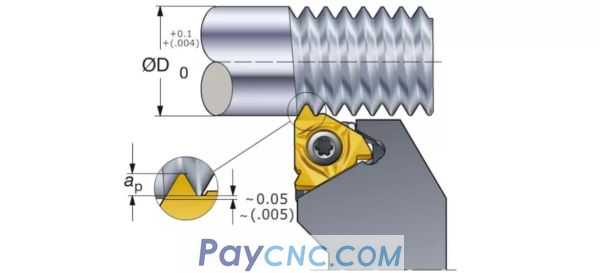
Recommended value of external thread feed (ISO metric):

Ensure that the workpiece and tool are aligned:
Use the maximum centerline deviation of ±0.1mm. If the cutting edge position is too high, the relief angle will decrease, and the cutting edge will be scratched (broken); if the cutting edge position is too low, the thread profile may be incorrect.

5. Successful application skills of thread turning
1) Before thread turning, check whether the workpiece diameter has the correct machining allowance, and add 0.14mm as the crown allowance.
2) Position the tool accurately in the machine tool.
3) Check the setting of the cutting edge relative to the middle diameter.
4) Make sure to use the correct blade geometry (A, F or C).
5) Ensure adequate and uniform clearance (blade-inclined blade pad) by selecting the appropriate blade pad to obtain the correct flank clearance.
6) If the thread is not qualified, check the entire clamping including the machine tool.
7) Check the available CNC programs for thread turning.
8) Optimize the feeding method, number of passes and size.
9) Ensure the correct cutting speed to meet the application requirements.
10) If the thread pitch of the workpiece thread is wrong, check whether the machine thread pitch is correct.
11) Before cutting into the workpiece, it is recommended that the tool should start with a minimum distance of 3 times the pitch.
12) High-precision coolant can extend tool life and improve chip control.
13) The quick-change system ensures simple and fast clamping.
When choosing a tool for the thread turning process, you should consider:
-Check the overhang and any clearance required (eg shoulder, counter-spindle, etc.)
-Minimize tool overhang for quick clamping
-For poor rigid clamping, choose a blade with lower cutting force
-High-precision coolant can extend tool life and improve cutting control
-Use plug-and-play coolant adaptor to easily connect coolant
-In order to ensure productivity and tool life, multi-tooth blades are preferred, with single-edge full-tooth blades being the second choice, with the lowest productivity and the shortest tool life being the V-tooth blades.
Blade wear and tool life:
Infeed method, optimize infeed method, number of passes and depth
Blade inclination angle to ensure a sufficiently large and uniform gap (blade-tilted blade pad)
Blade geometry, ensure the correct blade geometry (A, F or C geometry)
Blade material, choose the correct material according to the material and toughness requirements
Cutting parameters, if necessary, change the cutting speed and number of passes.
|
 |
| Products Catalogue | Home | About Us | Retrofit | Download | News | Tech Support | Contact Us | |
|
|
|
